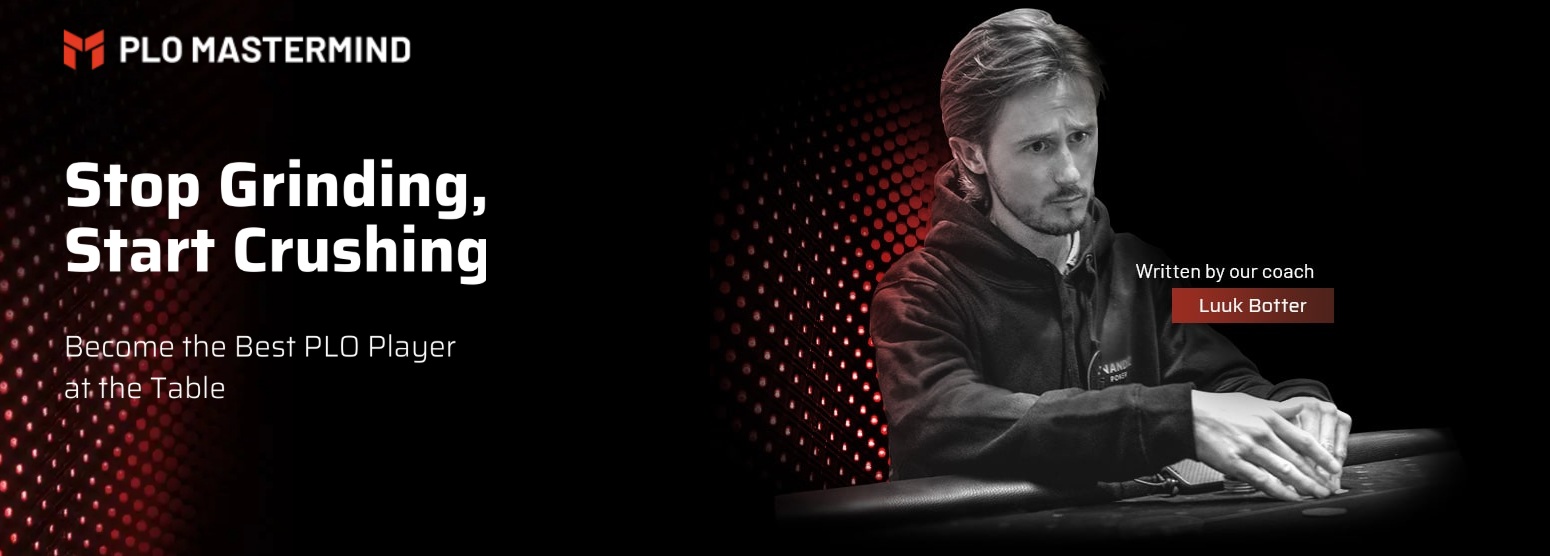
Check out how Luuk Botter, one of the head coaches at the Omaha Poker training site PLO Mastermind, is breaking down a tricky flop in under 5 minutes.
There are few feelings more challenging in Pot Limit Omaha than being out of position in a 3-bet pot facing a dynamic, connected flop. But don’t worry, Luuk Botter will break down how to play it step-by-step.
Situation: Button opens, we 3-bet from the Small Blind, and the Button calls.
The flop comes: [T♠] [8♦] [4♠]
We set the tone as the preflop aggressor, but now we’re out of position, and this board is flat-out scary. It connects with a huge part of our opponent’s range.
What’s our game plan?
Before Luuk Botter dive in, take a second and guess: with our entire range here, what percentage of the time should we be betting?
It’s a complex question with no easy answer. So, I want to walk you through how I personally use one of the most powerful features of the PLO Mastermind trainer, the Flop Matrix, to turn these confusing spots into simple, actionable takeaways.
The Flop Matrix helps you cut through the noise, visually organizing your entire range into a simple grid. After you select your main cards (e.g., ‘AA’ in our example below), each square in the grid you see represents two side-cards of AA.
- The diagonal line is the key: combinations in the top-right are ‘good suits’ (suited to your highest card), while those in the bottom-left are ‘bad suits’ (unsuited to your highest card).
- The colors instantly tell you the GTO strategy: Red means Bet, and Green means Check.
- The details window (bottom left) represents your filtered hands. In our example we start out with AA.
It’s the fastest way to turn a complex range into clear, visual patterns. So, we start by focusing on AA, which makes up about 28% of our hands.
When I first select “AA” in the Matrix to see how all my AA combos should be played, there is not clear pattern to the red (Bet) and green (Check). Trying to memorize this is impossible.

But this is where the magic begins. We take it to the next level by using filters. These are displayed on the right side of the Matrix.
First, let’s ask a simple question: How should I play my very best Aces?
I’ll filter for AA + Flush Draw + Backdoor Flush Draw. Instantly, the chaos disappears. The matrix is now almost solid red.

Takeaway #1: With our best possible Aces on this board (those with strong additional draws), we basically never slow-play. We bet for value, almost 100% of the time.
Easy enough, right?
Now another question: What about my weaker Aces?
I’ll adjust the filter to show only AA + Backdoor Flush Draw. Now, the matrix is a mix of red and green. But look closer, and a clear pattern emerges.
The hands we bet are the ones that have additional equity with a straight draw.
The hands we check are the ones that are more vulnerable, with no real backup plan.
Takeaway #2: With our more marginal Aces, we need additional equity (a straight draw) to feel comfortable betting. We don’t want to be in a tough spot if we get raised (or called and having to play a turn OOP against a strong range).
This is the true power of the Flop Matrix. Its purpose isn’t just to give you a single answer. Its purpose is to transform an overwhelmingly complex range into simple, actionable rules you can actually remember and use at the tables.
While we’ve focused on AA today, the power of the Flop Matrix lies in its ability to analyze countless hand combinations, giving you a comprehensive understanding of your entire range.
In just two minutes of study, we’ve gone from a confusing spot to two clear heuristics:
Takeaway #3: With my nuttiest Aces, I bet. With my marginal Aces, I only bet if I have a good draw to go with them.
That is how you build a world-class strategy, one simple takeaway at a time.
Keep crushing,
Luuk
As a PLO enthusiast with nearly 12 years of experience, I’m passionate about breaking down the complexities of Pot Limit Omaha, helping you sharpen your strategy and grow your bankroll – no matter your current level. I also share exclusive bonus and rakeback deals, along with discounts on poker courses and tools, so you can get an extra edge. When I’m not writing, you’ll usually find me online, playing PLO cash games and turbo MTTs.
